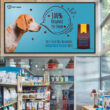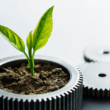by George Alam, Technical Product Manager at eddress
If you want a product, there’s probably a shop online that can deliver it to your address. Nowadays, 75% of people shop online at least once a month. It’s crazy to think how far digital commerce has gone in less than 30 years.
Indeed, the rise of digital channels has completely transformed the way people interact and shop since the launch of Netscape Navigator as a web browser in 1994.
The reinvention of e-commerce

e-commerce first appeared as a reliable solution to address the shortcoming of traditional retailing from brick-and-mortar stores or via sales reps. The first generation of e-commerce was born, focusing on providing a method to capture online orders. Meet 1995 Amazon, an e-commerce platform with a range of online books.
The second generation evolved to keep customers happy and increase sales by improving their experiences. The e-commerce 2.0 generation has seen the apparition of product recommendations, fast delivery, and a holistic multi-dimensional experience.
In 2005, Amazon launched the Prime membership that now offers same-day delivery to members. The growth process continues, combining multiple platforms, including social media shoppable ads and mobile payment methods.
Indeed, a not-so-new way of shopping that falls under a similar umbrella as e-commerce, is social commerce. Instead of checking out from a brand’s website, you check out directly from your social platform. One very promising social media empowering people to launch their businesses is Instagram. If you are an Instagrammer, you’ve noticed product catalogs and tags.
The beauty of technology is that today, anyone can launch their own business on social platforms at no cost whatsoever.
The ‘I want it all, I want it now’ customers

The pandemic drove the quest for faster and more convenient e-commerce, increasing the need for hyperfast delivery in a localized area, such as on-demand grocery shopping available at the customer’s doorstep in under an hour. q-commerce businesses, such as Gorillas, have boomed during COVID-19, bringing the customer experience to the next level.
The expectations of the first generation of shoppers who grew up with online delivery, Millennials, have been instrumental in introducing innovative changes to the e-commerce sector. Indeed, their need for instant gratification has shaped the online shopping process, from easier and faster transaction journeys — see the “click-to-buy” process on Amazon — to quicker delivery solutions.
The ‘I want it all, I want it now’ phenomenon is not just generational. It also coincided with quarantined consumers’ habits during the pandemic. That’s precisely where the development of hyperlocal delivery services has brought a new dimension to the online delivery sector.
Hyperlocal delivery makes it possible to bring essentials and food orders to customers in a short time by keeping the supply chain and fleet management close to the online shopper. That’s precisely why q-commerce ventures have boomed in cities during the pandemic, offering neighborhood delivery solutions.
Hyperlocal and last-mile delivery
As a q-commerce startup launching its activities, you may come across hyperlocal and last-mile delivery being used interchangeably. The terms refer to similar functions and end-goals, namely creating the best possible customer experience by delivering online orders faster and without delay. But the process does contain some differences.
Hyperlocal delivery is usually completed by couriers picking up goods from a retailer and delivering them directly to the customers. This could be the case with on-demand grocery shopping and requires the local presence of the store to act as a fulfillment center in the neighborhood. Hyperlocal delivery caters to the needs of shoppers within a particular geographical coverage and has a specific weight limitation for packages to be delivered. This is mainly due to the sort of transportation used; a bike or bicycle.
Last-mile delivery, on the other hand, is not restricted to a particular area or package constraints. It is characterized as the final leg of the process; the movement of goods from a shipping hub to the final shipping point, usually the buyer’s doorstep. The main focus of Last-Mile is to deliver the item to the end consumer as soon as possible relying on the item’s availability, as well as the distance between the product’s origin and destination.
Understandably, q-commerce ventures may combine hyperlocal and last-mile delivery services to expand their reach, using new hubs to access new locations. This process can also use robotics and automation to save time and manual labor during the middle-mile stage.
At eddress, we specialize in developing a white-labeled marketplace platform that lets you manage online orders and the whole delivery and fulfillment process. Not sure how beneficial a white-labeled solution is? We’ve prepared the right article for you.
Our team is always here to help! We’re just one click away.







